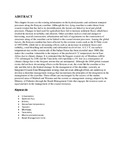| dc.description.abstract | This chapter focuses on the existing information on the hydrodynamics and sediment transport processes along the Kenyan coastline. Although the low-lying coastline is under threat from coastal erosion that has led to its destabilization, the factors are linked to local and global processes. Changes in land used for agriculture have led to increase sediment fluxes which have resulted in increase in turbidity and siltation. Other activities such as coral and mangrove harvesting, seawall construction, urbanization and lack of regulations on the construction of structures along of the coastline can be linked to the coastal erosion processes. Among the global factors, the Kenyan coastline has been affected by the extreme events such as the El Niño event of 1997/1998, which led to devastating effects such as an increase in sediment fluxes and turbidity, coral bleaching and mortality and substantial sea level rise. A 1.3 °C sea surface temperature rise on the western side of the Indian Ocean has been recorded since 1880; this makes the coastline vulnerable to the impacts of the predicted 6 °C temperature rise in East Africa due to climate change. It is estimated that the biggest coastal city of Mombasa will be 17% submerged by 2100 and the Tana delta will experience a 5% loss as a consequence of climate change due to the frequent storms that are anticipated. Although the 2004 global tsunami events did not have devastating effects on the Kenyan coast, the event hit the coastline at low tide and this led to the limited damage. In the management of the shoreline, currently an Integrated Coastal Zone Management strategy does not exist although efforts are underway to develop a shoreline management strategy that incorporates the principles of the integration in the management of the coastline. These efforts are encouraged by the success of the marine protected areas of Malindi and Watamu and the current co-management strategy adapted by the Ministry of Fisheries through the Beach Management Units that engages the resource users as equal partners in the management of the coastal resources.
Keywords
Urbanization;
Sediment flux;
El Niño;
Sea surface temperature;
Tsunami;
Mombasa;
Tana delta;
Marine protected areas;
Beach Management Units | en_US |

